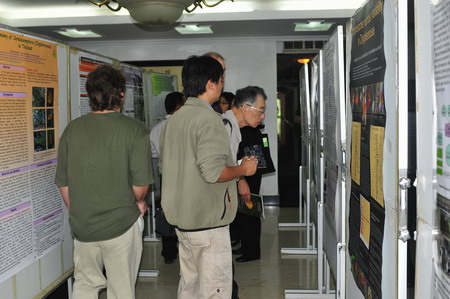
|
REGIONAL> Photo Galley
 |
|
Looking back over XTBG's tumultuous but steadfast development Longing for a greater adventure with a harmonious and unified effort
Updated: 2009-07-10 14:11 In 1978, the Spring of Science came in China. The leadership of XTBG was returned back to CAS. The Garden was named as “Yunnan Institute of Tropical Botany, the Chinese Academy of Sciences”. During the 10 years after his reappearance, Prof. Cai Xitao kept on working hard despite his illness. The framework of administration, scientific research and residence was primarily formed. The Institute made further advances in the exploration of medicinal plants, oil plants, aromatic plants, fruits, fast-growth timbers and studies on artificial plant communities. A lot of achievements had been made, among which 2 projects were awarded prizes at the national level, and 27 at the CAS, provincial or ministerial levels. At the same time, a batch of scientific personnel was well cultivated. In 1981, the Institute was stranded in adversity again. Prof. Cai Xitao passed away at 18:00, March 19, which left all the staffs in deep sorrow and grief. In 1984, a large number of experiment fields and agriculture lands were water-logged by the heavy floods in the Luosuo River. In 1985, many houses were destroyed by hurricane and torrential rains, and the cable bridge was demolished. In 1988, a 7.0 magnitude earthquake made most of the houses in terrible conditions. As everything was waiting to be improved for the whole nation, funds of the Chinese Academy of Sciences were very limited. Focusing attention on the development of institutions in urban cities, few funds could be earmarked to develop Yunnan Institute of Tropical Botany in such a remote area.
 After the system reconstructing in 1987, which returned the name of Xishuangbanna Tropical Botanical Garden, XTBG fell into another period of hardships. Under such adverse circumstances, the development of XTBG was like sailing a boat against the current. However, XTBG leaders never evaded from difficulties. They decided to give full play to self-reliance. Four enterprises of tourism, pharmacy and science development were set up; 10 million loans were totally used to reconstruct the gardening landscape, which were very uncommon among research institutions. By 1997, XTBG has got an annual income of 10 million RMB. The increased income supported the garden construction, stabilized the team, and broke the deadlock of scientific research. All in all, XTBG was going on the track of sound development. The number of collected plant species has gradually increased to over 4,000 from the stagnated 2,000. Taking the geological advantages of Xishuangbanna into play, XTBG carried out studies on biodiversity conservation at an earlier stage. Since the 8th five-year plan period, XTBG has been granted by National Natural Science Foundations of China, Yunnan Provincial Natural Science Foundation, Spark Plan, and other programs. Closely following the international academic forefront, XTBG has undertaken the “Studies on Fig Trees - Keystone Species in Tropical Rainforest” under the “National Scaling-up of Science & Technology Heights”, “Green Island Effect of Fragmented Tropical Rainforest and Species Diversity Change” and “Biological Mechanism Underlying the Ex Situ Conservation of Rare and Endangered Plant Species”. Meanwhile, XTBG has made influence on neighboring countries by implementing international cooperation programs like the program funded by the John D. and Catherine T. MacArthur Foundation in Laos. During this period, the first Tropical Plant Germplasm Bank was erected. Scientific facilities were bettered and improved. XTBG revived itself from ups and downs. In February 1997, the Chinese Academy of Sciences made a decision to separate XTBG from Kunming Institute of Botany, and combine it with Kunming Institute of Ecology. Thus, the new Xishuangbanna Tropical Botanical Garden (XTBG) came into being. III. Counting on the Initiation of Knowledge Innovation Program, XTBG in Sound and All-Rounded Development In late 1998, XTBG became a pilot institution of CAS Knowledge Innovation Program. Over the past 10 years, XTBG has made further advances in scientific research, species conservation, living collections expanding, public science education and team building, in a stage of steadfast and all-rounded development. XTBG’s scientific research is centered on conservation biology, forest ecosystem ecology and resource plants. Following closely with the development trend of disciplines nationally and internationally, facing the national need and international academic forefront, XTBG has further enhanced its scientific targets and deployed research groups. Up to now, XTBG has set up 20 research groups in total. Since the implementation of CAS Knowledge Innovation Program, XTBG has made significant achievements in scientific research. Among the 1,000 academic papers, 248 have been published in international peer-reviewed journals, Nature included. Each year, over 10 academic papers are published in internationally top journals. About 30 books on scientific research and public science education have been published. A batch of research projects, including “Discovery and Nomination of Flexistyle Outcrossing Mechanism in Alpinia (Zingiberaceae)”, “Tropical Plant Resource Conservation and Its Sustainable Use”, “Ecological Effect Mechanisms of Epiphytes in Montane Evergreen Broad-leaved Forest”, “Tropical Forest Dynamics in Southwestern China”, “Evaluation on Ornamental Characteristics and Selection for Promising Species of Native Zingiberaceous Plants in China”, etc have been awarded first or second prizes of Natural Science Award and Science & Technology Progress of Yunnan Province. |